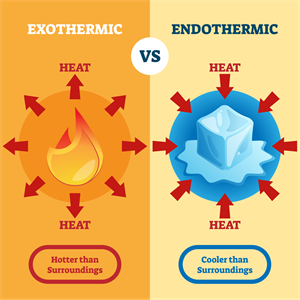PDF chapter test TRY NOW
Experiment 3: To determine the change in temperature during chemical reactions and conclude whether the reaction is exothermic or endothermic.

CAUTION: Handle the acid with care.
Materials required:
-Sodium hydroxide solution
-Hydrochloric acid
-Ammonium chloride (solid)
-Barium hydroxide (solid)
-Weighing balance
-Watch glass
-Four beakers
-Thermometer and
-Glass rod
Experimental procedure:
Step 1: Mark all the four clean beakers as 1, 2, 3, and 4.
Step 2: Take 20 mL of sodium hydroxide solution in beaker no. 1, 20 mL of hydrochloric acid in beaker no. 2, 15.75 g of barium hydroxide in beaker no. 3, and 5.35 g of ammonium chloride in beaker no. 4.
Step 3: Successively inject a thermometer in each beaker for some time and record their temperatures. Also, record the room temperature.
Step 4: To observe the reaction of sodium hydroxide solution with hydrochloric acid, pour the contents of beaker no. 1 in beaker no. 2. Quickly insert the thermometer into the reaction mixture. Note and record its initial temperature reading. Stir well the reaction mixture smoothly using a glass rod. Note and record the final temperature reading of the thermometer. Wash the thermometer and glass rod after noting the readings.
Step 5: Similarly, to see the reaction of barium hydroxide solution with ammonium chloride, pour the beaker no. 3 in beaker no. 4. Quickly inject the thermometer into this reaction mixture. Note and record the initial temperature. Stir well the reaction mixture smoothly using the glass rod. Note and record the final temperature readings of the thermometer.
Observation and calculation:
Room temperature = __________ °C = __________ K
Temperature of the sodium hydroxide solution = __________ °C = __________ K
Temperature of the hydrochloric acid = __________ °C = __________ K
Temperature of the barium hydroxide solution = __________ °C = __________ K
Temperature of the ammonium chloride = = __________ °C = __________ K
| No. | Reactants of the reactions | Initial temperature of the reaction mixture | Final temperature of the reaction mixture | Change in temperature |
θ_1 °C | θ_2 °C | θ_2 - θ_1 °C | ||
1 | NaOH + HCl | |||
2 | Ba(OH)_2.8H_2O + 2NH_4Cl |
Important!
Note: In the laboratory, the students need to perform this experiment with the assistance of their teacher. Record the initial and final temperature readings to observe any changes in temperature.
Results:
When sodium hydroxide reacts with hydrochloric acid to produce sodium chloride and heat, this reaction is said to be exothermic. Similarly, when barium hydroxide and ammonium chloride reaction absorb heat, this reaction is said to be endothermic.
Exo and endothermic reactions:
NaOH(aq) + HCl(g) → NaCl(g) + H_2O(l) + Heat
Ba(OH)_2.8H_2O(s) + 2NH_4Cl(s) → BaCl_2(aq) + 10H_2O(l) + 2NH_3(aq) - Heat
The reaction between sodium hydroxide solution and hydrochloric acid is exothermic. The reaction between barium hydroxide and ammonium chloride is endothermic.
Conclusion:
We already know that temperature change is a chemical reaction. This experiment clearly shows the chemical reaction, which means the sodium chloride formation reaction produces heat, indicating an exothermic reaction. Similarly, the reaction of barium chloride formation absorbs heat, making it an endothermic reaction.
